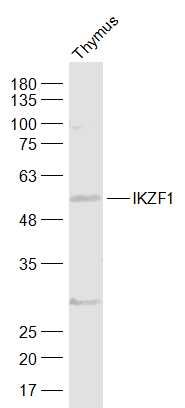产品货号 : mlR8172
英文名称 : IKZF1/DNA-binding protein Ikaros
中文名称 : 锌指蛋白IKAROS抗体
别 名 : IKAROS family zinc finger 1 (Ikaros); PRO0758; CLL associated antigen KW 6; DNA-binding protein Ikaros; hIk 1; hIk-1; IK1; Ikaros (zinc finger protein); IKAROS; Ikaros family zinc finger protein 1; Ikzf1; IKZF1_HUMAN; LYF1; Lymphoid transcription factor LyF-1; zinc finger protein subfamily 1A 1; ZNFN1A1.
研究领域 : 肿瘤 细胞生物 细胞凋亡 锌指蛋白 表观遗传学
抗体来源 : Rabbit
克隆类型 : Polyclonal
交叉反应 : Human, Mouse, Rat, Chicken,
产品应用 : WB=1:500-2000 ELISA=1:500-1000 IHC-P=1:400-800 IHC-F=1:400-800 IF=1:100-500 (石蜡切片需做抗原修复)
not yet tested in other applications.
optimal dilutions/concentrations should be determined by the end user.
分 子 量 : 57kDa
细胞定位 : 细胞核 细胞浆
性 状 : Lyophilized or Liquid
浓 度 : 1mg/ml
免 疫 原 : KLH conjugated synthetic peptide derived from human IKAROS:251-360/519
亚 型 : IgG
纯化方法 : affinity purified by Protein A
储 存 液 : 0.01M TBS(pH7.4) with 1% BSA, 0.03% Proclin300 and 50% Glycerol.
保存条件 : Store at -20 °C for one year. Avoid repeated freeze/thaw cycles. The lyophilized antibody is stable at room temperature for at least one month and for greater than a year when kept at -20°C. When reconstituted in sterile pH 7.4 0.01M PBS or diluent of antibody the antibody is stable for at least two weeks at 2-4 °C.
PubMed : PubMed
产品介绍 : This gene encodes a transcription factor that belongs to the family of zinc-finger DNA-binding proteins associated with chromatin remodeling. The expression of this protein is restricted to the fetal and adult hemo-lymphopoietic system, and it functions as a regulator of lymphocyte differentiation. Several alternatively spliced transcript variants encoding different isoforms have been described for this gene. Most isoforms share a common C-terminal domain, which contains two zinc finger motifs that are required for hetero- or homo-dimerization, and for interactions with other proteins. The isoforms, however, differ in the number of N-terminal zinc finger motifs that bind DNA and in nuclear localization signal presence, resulting in members with and without DNA-binding properties. Only a few isoforms contain the requisite three or more N-terminal zinc motifs that confer high affinity binding to a specific core DNA sequence element in the promoters of target genes. The non-DNA-binding isoforms are largely found in the cytoplasm, and are thought to function as dominant-negative factors. Overexpression of some dominant-negative isoforms have been associated with B-cell malignancies, such as acute lymphoblastic leukemia (ALL). [provided by RefSeq, May 2014]
Function:
Transcription regulator of hematopoietic cell differentiation. Binds gamma-satellite DNA. Binds with higher affinity to gamma satellite A. Plays a role in the development of lymphocytes, B- and T-cells. Binds and activates the enhancer (delta-A element) of the CD3-delta gene. Repressor of the TDT (terminal deoxynucleotidyltransferase) gene during thymocyte differentiation. Regulates transcription through association with both HDAC-dependent and HDAC-independent complexes. Targets the 2 chromatin-remodeling complexes, NuRD and BAF (SWI/SNF), in a single complex (PYR complex), to the beta-globin locus in adult erythrocytes. Increases normal apoptosis in adult erythroid cells. Confers early temporal competence to retinal progenitor cells (RPCs).
Subunit:
Heterodimer with other IKAROS family members. Interacts with IKZF4 AND IKZF5 (By similarity). Component of the chromatin-remodeling NuRD repressor complex which includes at least HDAC1, HDAC2, RBBP4, RBBP7, IKZF1, MTA2, MBD2, MBD3, MTA1L1, CHD3 and CHD4. Interacts directly with the CHD4 component of the NuRD complex. Component of the BAF (SWI/SNF) gene activator complex which includes ACTB, ARID1A, ARID1B, IKZF1, ARID1A, ARID1B, SMARCA2, SMARCA4 and at least one BAF subunit. Interacts directly with the SMARCA4 component of the BAF complex. Interacts with SUMO1; the interaction sumoylates IKAROS, promoted by PIAS2 and PIAS3. Interacts with PIAS2 (isoform alpha); the interaction promotes sumoylation and reduces transcription repression. Interacts, to a lesser extent, with PIAS3. Interacts with PPP1CC; the interaction targets PPP1CC to pericentromeric heterochromatin, dephosphorylates IKAROS, stabilizes it and prevents it from degradation. Interacts with IKZF3.
Subcellular Location:
Nucleus. Note=In resting lymphocytes, distributed diffusely throughout the Nucleus. Note=In resting lymphocytes, distributed diffusely throughout the nucleus. Localizes to pericentromeric heterochromatin in proliferating cells. This localization requires DNA binding which is regulated by phosphorylation / dephosphorylation events. Isoform Ik2: Nucleus. Note=In resting lymphocytes, distributed diffusely throughout the nucleus. Localizes to pericentromeric heterochromatin in proliferating cells. This localization requires DNA binding which is regulated by phosphorylation / dephosphorylation events. Isoform Ik6: Cytoplasm.
Tissue Specificity:
Abundantly expressed in thymus, spleen and peripheral blood Leukocytes and lymph nodes. Lower expression in bone marrow and small intestine.
Post-translational modifications:
Phosphorylation controls cell-cycle progression from late G(1) stage to S stage. Hyperphosphorylated during G2/M phase. Dephosphorylated state during late G(1) phase. Phosphorylation on Thr-140 is required for DNA and pericentromeric location during mitosis. CK2 is the main kinase, in vitro. GSK3 and CDK may also contribute to phosphorylation of the C-terminal serine and threonine residues. Phosphorylation on these C-terminal residues reduces the DNA-binding ability. Phosphorylation/dephosphorylation events on Ser-13 and Ser-295 regulate TDT expression during thymocyte differentiation. Dephosphorylation by protein phosphatase 1 regulates stability and pericentromeric heterochromatin location. Phosphorylated in both lymphoid and non-lymphoid tissues.
Sumoylated. Simulataneous sumoylation on the 2 sites results in a loss of both HDAC-dependent and HDAC-independent repression. Has no effect on pericentromeric heterochromatin location. Desumoylated by SENP1.
Polyubiquitinated.
DISEASE:
Note=Defects in IKZF1 are frequent occurrences (28.6%) in acute lymphoblasic leukemia (ALL). Such alterations or deletions lead to poor prognosis for ALL.
Similarity:
Belongs to the Ikaros C2H2-type zinc-finger protein family.
Contains 6 C2H2-type zinc fingers.
SWISS:
Q13422
Gene ID:
10320
Important Note:
This product as supplied is intended for research use only, not for use in human, therapeutic or diagnostic applications.
产品图片












